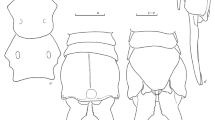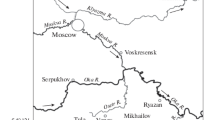Abstract
In recent decades, the strepsirhine family, Lorisidae1, has been thought of as consisting taxonomically of only four extant genera, of which two are considered to be monotypic: the Asian Loris (which is now apparently confined to the island of Sri Lanka), and the African Perodicticus potto. The African genus, Arctocebus, apparently comprises two species, A. calabarensis and A. aureus. And the Asian genus Nycticebus also is supposed to embrace only two species, N. pygmaeus and the somewhat larger N. coucang. N. pygmaeus is distributed roughly throughout the mainland of southeast Asia. N. coucangis sympatric with N. pygmaeus on the mainland, but also occurs on the islands of Borneo, Sumatra, Java, and, purportedly, the Philippines.
Access this chapter
Tax calculation will be finalised at checkout
Purchases are for personal use only
Preview
Unable to display preview. Download preview PDF.
Similar content being viewed by others
References
Dao, V. T. (1960). Sur un nouvelle especes Nycticebus au Vietnam. Zoologisches Anzeiger, 164, 240–243.
Elliot, D. G. (1912). A Review of the Primates, volume 1. New York: The American Museum of Natural History.
Gaulin, S. J. C., & Robbins, C. J. (1991. Trivers-Willard effect in contemporary North American society. American Journal of Physical Anthropology, 85, 61–69.
Gingerich, P. D., & Ryan, A. S. (1979). Dental and cranial variation in living Indriidae. Primates, 20, 141–159.
Gray, J. E. (1821). On the natural arrangement of vertebrose animals. London Medical Repository, 15, 296–310.
Gray, J. E. (1825). Outline of an attempt at the disposition of the mammalia into tribes and families with a list of the genera apparently appertaining to each tribe. Annals of Philosophy, 26, new series 10, 337–344.
Gregory, W. K. (1922). The Origin and Evolution of the Human Dentition. Baltimore: Williams and Wilkins.
Groves, C. P. (1971). Systematics of the genus Nycticebus. Proceedings of the 3rd International Congress of Primatology, Zurich, 1970, volume 1, 44–53.
Groves, C. P. (1974). Taxonomy and phylogeny of prosimians. In R. D. Martin, G. A. Doyle & A. C. Walker (Eds.), Prosimian Biology (pp. 449–473). London: Duckworth Press.
Jenkins, P. D. (1987). Catalogue of Primates in the British Museum (Natural History). Part TV: Suborder Strepsirrhini, including the subfossil Madagascar! lemurs and Family Tarsiidae. London: British Museum (natural History).
Schwartz, J. H. (1974). Dental development and eruption in the prosimians and its bearing on their evolution. Ph.D. thesis, Columbia University, New York City.
Schwartz, J. H. (1986). Primate systematics and a classification of the order. In D. R. Swindler and J. Erwin (Eds.), Comparative Primate Biology, volume 1: Systematics, Evolution, and Anatomy (pp. 1–41). New York: Alan R. Liss.
Schwartz, J. H., & Tattersall, I. (1985). Evolutionary relationships of living lemurs and lorises (Mammalia, Primates) and their potential affinities with European Eocene Adapidae. Anthropological Papers of the American Museum of Natural History, 60, 1–100.
Zhang, Y., Chen, Z. & Shi, L. 1993. Phylogeny of the slow lorises (Genus Nycticebus): an approachusing mitochondrial DNA restriction enzyme analysis. International Journal of Primatology, 14, 167–175.
Author information
Authors and Affiliations
Editor information
Editors and Affiliations
Rights and permissions
Copyright information
© 1995 Springer Science+Business Media New York
About this chapter
Cite this chapter
Schwartz, J.H., Beutel, J.C. (1995). Species Diversity in Lorisids: A Preliminary Analysis of Arctocebus, Perodicticus, and Nycticebus . In: Alterman, L., Doyle, G.A., Izard, M.K. (eds) Creatures of the Dark. Springer, Boston, MA. https://doi.org/10.1007/978-1-4757-2405-9_12
Download citation
DOI: https://doi.org/10.1007/978-1-4757-2405-9_12
Publisher Name: Springer, Boston, MA
Print ISBN: 978-1-4419-3250-1
Online ISBN: 978-1-4757-2405-9
eBook Packages: Springer Book Archive




